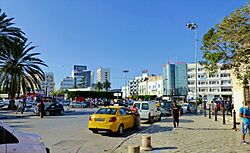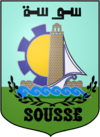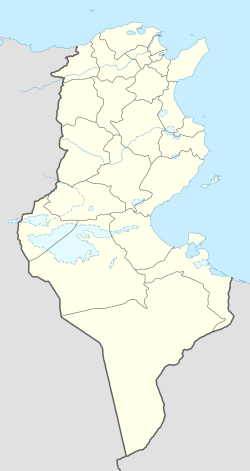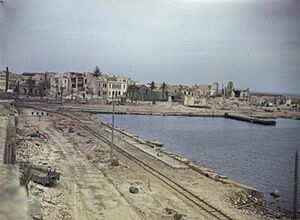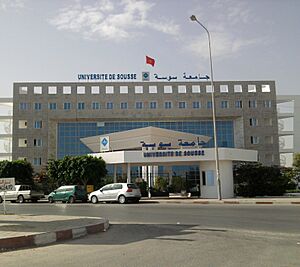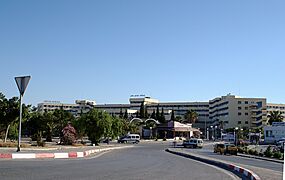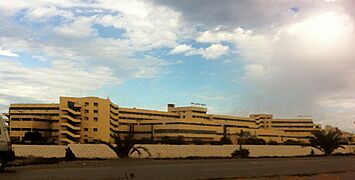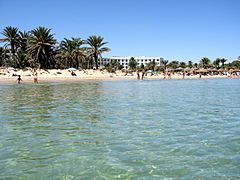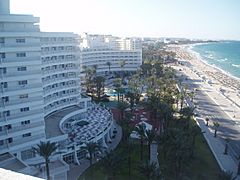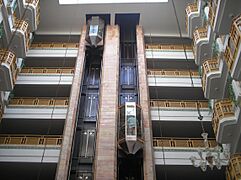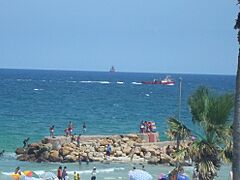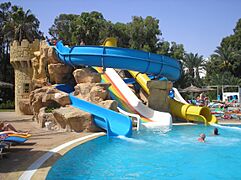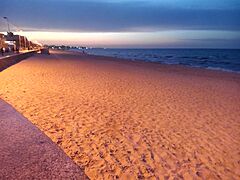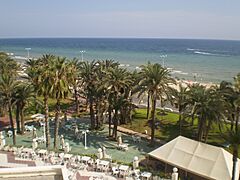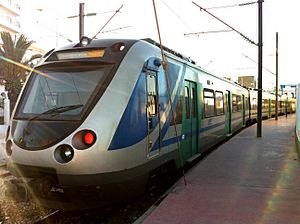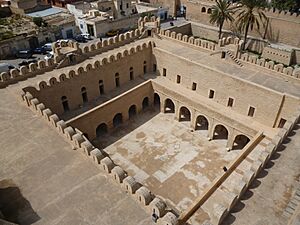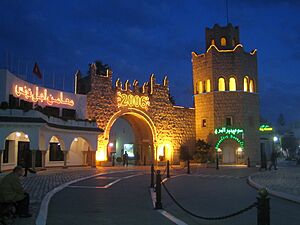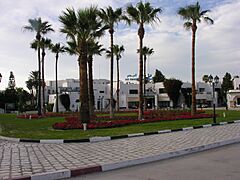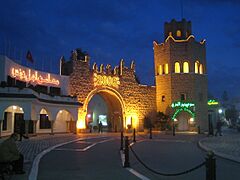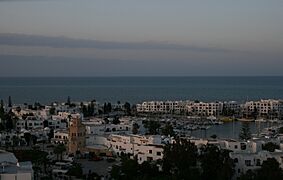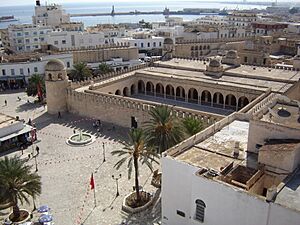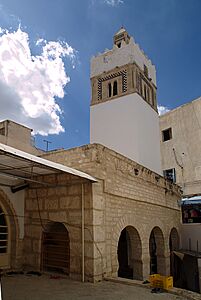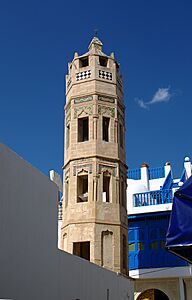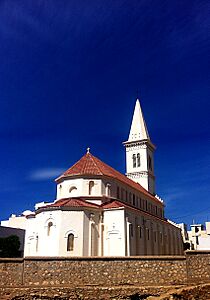Sousse facts for kids
Quick facts for kids
Sousse
سوسة
|
|||
|---|---|---|---|
|
Counter-clockwise from top:
Centre Ville of Sousse, aerial view of Sousse, Great Mosque of Sousse, Port El Kantaoui, El Finga, Medina of Sousse |
|||
|
|||
| Nickname(s):
"The pearl of the Sahel"
|
|||
| Country | |||
| Governorate | Sousse Governorate | ||
| Delegation(s) | Sousse Jawhara, Sousse Medina, Sousse Riadh, Sousse Sidi Abdelhamid | ||
| Population
(2022)
|
|||
| • City | 314,071 | ||
| • Metro | 753,670 | ||
| Time zone | UTC+1 (CET) | ||
| • Summer (DST) | UTC+1 (CET) | ||
| UNESCO World Heritage Site | |||
| Official name | Medina of Sousse | ||
| Criteria | Cultural: (iii)(iv)(v) | ||
| Inscription | 1988 (12th Session) | ||
| Extensions | 2010 | ||
| Area | 31.68 ha (0.1223 sq mi) | ||
| Buffer zone | 60.99 ha (0.2355 sq mi) | ||
Sousse (also spelled Soussa) is a lively city in Tunisia. It is the capital of the Sousse Governorate. The city is about 140 kilometers (87 miles) south of Tunis, the country's capital. In 2014, Sousse had about 271,428 people living there.
Sousse is located in the central-east part of Tunisia, right on the Gulf of Hammamet. This gulf is a part of the big Mediterranean Sea. The city's economy relies on making things like transport equipment, processed food, olive oil, and textiles. Tourism is also a very important part of its economy. Sousse is also home to the Université de Sousse, a major university.
Contents
What's in a Name?
The names Sousse and Soussa are both French ways to spell the Arabic name Sūsa. This city also includes the old ruins of a place called Hadrumetum. Hadrumetum had many different names in ancient times.
Where is Sousse?
Sousse is in the middle of Tunisia, on the coast of the Tunisian Sahel. It borders the Mediterranean Sea to the east. The city covers an area of 45 square kilometers (17 square miles) and is 25 meters (82 feet) above sea level.
Sousse is located between two seasonal rivers called wadis. The Wadi Bliban is to the north and northwest, and the Wadi al-Halluf is to the southeast. The ground beneath Sousse is mostly made of sedimentary rock and some newer river deposits near the coast. Winters in Sousse are usually mild. The city gets rain about 69 days a year and enjoys a lot of sunshine.
How Sousse is Governed
The Municipality of Sousse is the main city of a governorate (a region) that spans over 2,669 square kilometers (1,031 square miles). The city itself is split into four main areas: Sousse Nord, Sousse Sud, Sousse Médina, and Sousse Riadh. These areas help manage the city's services.
A Look Back in Time: Sousse's History

Ancient Hadrumetum
Around 1100 BC, people from Tyre (an ancient city) set up Hadrumetum as a trading post. It was a stop along their trade routes to Italy and the Strait of Gibraltar. Hadrumetum was built even before Carthage. Later, it became part of the Carthaginian Empire.
Hadrumetum played a role in several wars, including the Punic Wars. During the Third Punic War, it helped Rome against Carthage. This earned it more land and special rights. It was also important during Caesar's Civil War. Legend says that when Julius Caesar tripped while landing there, he grabbed handfuls of dirt and famously declared, "I have you now, Africa!" (Teneo te Africa!).
After Carthage, Hadrumetum was the second most important city in Roman Africa. It became the capital of the province of Byzacena. Famous people from Hadrumetum include the lawyer Salvius Julianus and the emperor Clodius Albinus. The city also has many early Christian saints. Large catacombs (underground burial places) from Roman and Byzantine times are found beneath the city.
The Vandals attacked Hadrumetum in 434 AD. Even so, it remained an important place in their kingdom. Later, the Byzantine Empire took control of the town in 534 AD. They built new defenses and churches. However, the town was destroyed during the Umayyad Caliphate's conquest of North Africa in the 7th century. An old report from 1987 says that the city was almost completely destroyed.
Medieval Susa
After the Muslim Arab armies arrived, they quickly spread Arab culture across the region. Under the Aghlabids, a new city called Susa was built near the ruins of Hadrumetum. It became their main port. In 827, their invasion of Sicily mostly started from Susa's harbor.
After the Byzantine city of Melite (now Mdina in Malta) was captured in 870, marble from its churches was used to build the Ribat in Susa. The Ribat is a tall building that served as both a minaret (a tower for calling to prayer) and a watchtower. It is still in excellent condition today and attracts visitors. The city's main mosque, also built in the 9th century, looks like a fortress.
Susa was briefly taken over by Norman Sicily in the 12th century. It then fell to the Ottoman Empire in the 16th century. In the 18th century, a fleet from France and Venice attacked it.
During the Middle Ages, Susa was famous for its textile industries. It produced silk and flax fabrics called Sūsī. Its special robes, called shuqqas, were very well-known. Some were even mass-produced and sold ready-to-wear across the Mediterranean Sea.
After the city of Mahdia declined in the 15th and 16th centuries, Susa became the most important town in the Sahel region. It had about 15,000 people.
Sousse in Colonial Times
Tunisia became a French protectorate in 1881. By the late 1800s, Sousse had about 7,000 people. It was the second most important city in Tunisia, after Tunis. At this time, everyone in Sousse lived inside the walled medina (old city). The French Protectorate helped Sousse grow as a center for trade and government. They built public buildings, made the city's port bigger, and constructed railways.
Between 1896 and 1911, railways connected Sousse to other cities like Tunis and Sfax. Food industries also started in the city. Before World War I, Sousse had about 25,000 people. This included many French and other Europeans.
New areas outside the old city walls began to develop during this time. However, not many people lived there until after World War II. Sousse was heavily damaged during the war, with 39 bombings between December 1942 and May 1943. After the war, rebuilding Sousse became a top priority.
Modern Sousse
When Tunisia became independent in 1956, Sousse continued to grow rapidly. From just 8,577 people in 1885, its population grew to 134,835 in 1994. The city's physical size also increased a lot. Its economy grew too, especially in services and industries.
Sousse still has its traditional Arabian look and feel. Today, it is seen as one of the best examples of Arab sea-facing defenses. With about 200,000 people, Sousse has a medieval heart with narrow, winding streets, a kasbah (fortress), and a medina. It also has its ribat fortress and a long wall along the Mediterranean coast. Around this old part is a modern city with wide, straight roads and more spread-out buildings.
In 2015, an event occurred where a gunman attacked tourists on a beach, causing many casualties.
City Views
People of Sousse
| Historical population | ||
|---|---|---|
| Year | Pop. | ±% |
| 1993 | 421,800 | — |
| 2006 | 568,200 | +34.7% |
| 2007 | 579,000 | +1.9% |
| 2008 | 590,100 | +1.9% |
| 2009 | 608,600 | +3.1% |
| 2010 | 621,758 | +2.2% |
| 2011 | 635,122 | +2.1% |
| 2012 | 648,695 | +2.1% |
| 2013 | 662,481 | +2.1% |
| 2014 | 677,500 | +2.3% |
| 2015 | 690,700 | +1.9% |
| 2016 | 703,600 | +1.9% |
| 2017 | 716,600 | +1.8% |
| 2019 | 737,027 | +2.9% |
As of 2019, Sousse had a population of 737,027 people. In 2014, males made up about 50.1% of the population, and females made up 49.9%.
Education and Healthcare
Sousse is home to the University of Sousse. This university includes the Ibn El Jazzar Faculty of Medicine, the Sousse National School of Engineers, and the Higher Institute of Music of Sousse. The music institute was founded in 1999.
The city also has many high schools, such as the pilot high school of Sousse and the Tahar-Sfar high school. There are also colleges like the Pilot College of Sousse.
For healthcare, Sousse has the Hospital of Sahloul. It is the largest hospital in the region.
Sousse's Economy
The most important economic activity in Sousse is the tertiary sector (services). This sector employs over 50% of the city's workers. It includes jobs in administration, education, healthcare, trade, and banking.
The secondary sector (industry) is also very important, employing 45% of the workers. This includes industries like textiles, leather, construction, and electronics. Only a small number of people work in the primary sector, mainly fishing.
Sousse has a port that is important for trade in central Tunisia. It helps regions like Kairouan and Kasserine. Sousse is the third largest city in Tunisia, after Tunis and Sfax. While it is known for making olive oil and other products, tourism is the main industry today. The area has many olive groves, covering more than 2,500 square kilometers (965 square miles). These groves have been a source of wealth since ancient times.
Tourism in Sousse
Sousse is a very popular place for tourists. It has a hot semi-arid climate, which means it has hot, dry summers and warm, mild, wet winters. Its location by the sea makes it a good place to visit all year round. The beautiful sandy beaches are surrounded by orchards and olive groves.
Many hotels are located along 20 kilometers (12 miles) of coastline, stretching north from the old city (medina) to Port El Kantaoui. These hotels can host 40,000 guests. About 1.2 million visitors come to Sousse every year. They enjoy the hotels, restaurants, nightclubs, casinos, beaches, and sports facilities.
Sousse is especially known for its nightlife. Popular nightclubs include Bora Bora and Living. Famous DJs often come to play music at these clubs. The tourist season usually starts in early June and ends in early October.
- Beaches and some hotels in Sousse
Getting Around Sousse
Sousse has good connections to Tunisia's main railway network. There are train lines to Tunis (since 1899), Sfax (since 1911), and Kasserine (since 2004). The main train station, Gare Sousse, is in the city center.
Since 2010, the electric Sahel Metro line goes south to Monastir Habib Bourguiba International Airport, Monastir, and Mahdia. This line has five stations within Sousse.
You can also travel between Sousse and other Tunisian cities using intercity buses and shared taxis called louages. Within Sousse, there are city buses, blue-strip louages, and regular taxis.
Places to See
The Old City (Medina)
The medina is the old part of Sousse, surrounded by city walls and defenses. It is full of history. Inside the medina, you'll find open-air and covered markets (souks). Important historical buildings include the ribat castle, the central mosque, and a historical museum in the Casbah. The museum has beautiful mosaics from ancient Roman villas in the area. You can also visit the old Carthaginian catacombs.
In 1988, UNESCO declared the medina of Sousse a World Heritage Site. They recognized its historical importance and how well it has been preserved from modern changes.
Port El Kantaoui
Port El Kantaoui is a special tourist area built around a port. It was created in 1979 specifically for tourism.
The buildings here are modern and bright white, but their design is inspired by traditional Tunisian architecture. They feature narrow streets and arches. Hotels line the beachfront for miles, stretching from Sousse itself to the harbor of Port El Kantaoui and beyond.
Important Religious Buildings
The Great Mosque
The Great Mosque is located at the entrance to the medina. It was built by the Aghlabid ruler Aboul Abbas I in 850–851 AD. This was about 30 years after the Ribat of Sousse was built. This mosque is a symbol of the city, which became the second most important city in the region. The building was made larger later during the rule of Ibrahim II.
Other Religious Sites
- Bou Ftetah Mosque
- Médersa El Zaqqaq (a type of school)
- Église Saint-Félix (Saint Felix Church)
Sports in Sousse
Sousse is home to Étoile Sportive du Sahel, a big sports club that plays many different sports. Football (soccer) is the most popular sport in the city. The ES Sahel football team has won the Tunisian football championship ten times and the Tunisian Cup ten times. Their home stadium is Stade Olympique de Sousse. Handball, basketball, and volleyball are also very popular sports in Sousse.
Sousse's Climate
Sousse has a hot semi-arid climate. This means it's usually dry and hot, but being by the sea makes the weather milder. It has hot, dry summers and warm, mild, wet winters.
The highest temperature ever recorded in Sousse was 48°C (118°F) on August 28, 2007. The lowest temperature recorded was 4.5°C (40°F) on December 27, 1993.
| Climate data for Sousse | |||||||||||||
|---|---|---|---|---|---|---|---|---|---|---|---|---|---|
| Month | Jan | Feb | Mar | Apr | May | Jun | Jul | Aug | Sep | Oct | Nov | Dec | Year |
| Record high °C (°F) | 27 (81) |
30 (86) |
37 (99) |
36 (97) |
43 (109) |
47 (117) |
47 (117) |
48 (118) |
42 (108) |
40 (104) |
31 (88) |
30 (86) |
48 (118) |
| Mean daily maximum °C (°F) | 15.8 (60.4) |
16.3 (61.3) |
17.8 (64.0) |
20.2 (68.4) |
23.4 (74.1) |
27.1 (80.8) |
30.7 (87.3) |
31.5 (88.7) |
30.2 (86.4) |
25.6 (78.1) |
20.8 (69.4) |
16.7 (62.1) |
23.0 (73.4) |
| Daily mean °C (°F) | 11.4 (52.5) |
11.7 (53.1) |
13.3 (55.9) |
15.6 (60.1) |
18.7 (65.7) |
22.4 (72.3) |
25.6 (78.1) |
26.2 (79.2) |
25.0 (77.0) |
20.9 (69.6) |
16.1 (61.0) |
12.4 (54.3) |
18.3 (64.9) |
| Mean daily minimum °C (°F) | 7.2 (45.0) |
7.4 (45.3) |
8.9 (48.0) |
11.0 (51.8) |
14.1 (57.4) |
17.8 (64.0) |
20.6 (69.1) |
20.9 (69.6) |
19.9 (67.8) |
16.3 (61.3) |
11.5 (52.7) |
8.1 (46.6) |
13.6 (56.6) |
| Record low °C (°F) | 4.8 (40.6) |
5 (41) |
5.5 (41.9) |
5.5 (41.9) |
9 (48) |
13 (55) |
14 (57) |
16 (61) |
15 (59) |
7 (45) |
5.5 (41.9) |
4.5 (40.1) |
4.5 (40.1) |
| Average rainfall mm (inches) | 43 (1.7) |
48 (1.9) |
35 (1.4) |
28 (1.1) |
15 (0.6) |
9 (0.4) |
2 (0.1) |
7 (0.3) |
35 (1.4) |
44 (1.7) |
35 (1.4) |
53 (2.1) |
354 (14.1) |
| Average rainy days | 7 | 6 | 7 | 6 | 5 | 2 | 1 | 2 | 4 | 6 | 6 | 7 | 59 |
| Mean daily sunshine hours | 6 | 7 | 7 | 8 | 10 | 11 | 12 | 11 | 9 | 7 | 7 | 6 | 8 |
| Source 1: Climate-Data.org, Weather2Travel for rainy days and sunshine | |||||||||||||
| Source 2: Voodoo Skies for record temperatures | |||||||||||||
| Jan | Feb | Mar | Apr | May | Jun | Jul | Aug | Sep | Oct | Nov | Dec |
|---|---|---|---|---|---|---|---|---|---|---|---|
| 16 °C (61 °F) | 16 °C (61 °F) | 16 °C (61 °F) | 16 °C (61 °F) | 18 °C (64 °F) | 21 °C (70 °F) | 24 °C (75 °F) | 26 °C (79 °F) | 25 °C (77 °F) | 23 °C (73 °F) | 21 °C (70 °F) | 18 °C (64 °F) |
Famous People from Sousse
- Ons Jabeur: A professional tennis player.
- Salvius Julianus: A very important lawyer and public official in ancient Rome.
- Mohamed Ghannouchi: A former prime minister of Tunisia.
- Hamadi Jebali: Another former prime minister of Tunisia.
- Aymen Abdennour: A footballer.
- Makrem Ben Romdhane: A basketball player.
- Zine El Abidine Ben Ali: A former President of Tunisia.
Sister Cities
Sousse is twinned with several cities around the world. This means they have special friendly relationships and often share culture and ideas.
 Boulogne-Billancourt, France
Boulogne-Billancourt, France Braunschweig, Germany
Braunschweig, Germany Constantine, Algeria
Constantine, Algeria İzmir, Turkey
İzmir, Turkey Latakia, Syria
Latakia, Syria Ljubljana, Slovenia
Ljubljana, Slovenia Marrakesh, Morocco
Marrakesh, Morocco Nice, France
Nice, France Thiès, Senegal
Thiès, Senegal Weihai, China
Weihai, China
Images for kids
See also
 In Spanish: Susa (Túnez) para niños
In Spanish: Susa (Túnez) para niños


